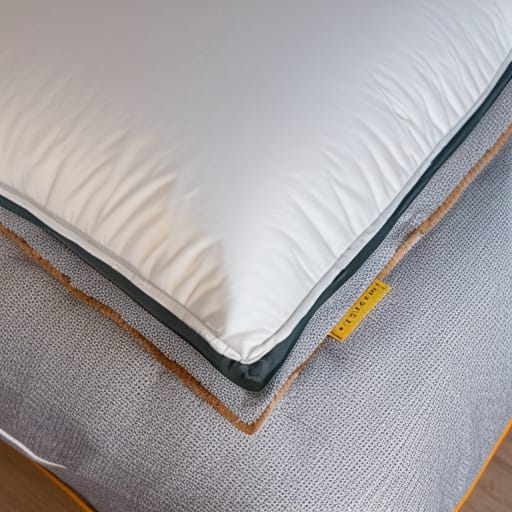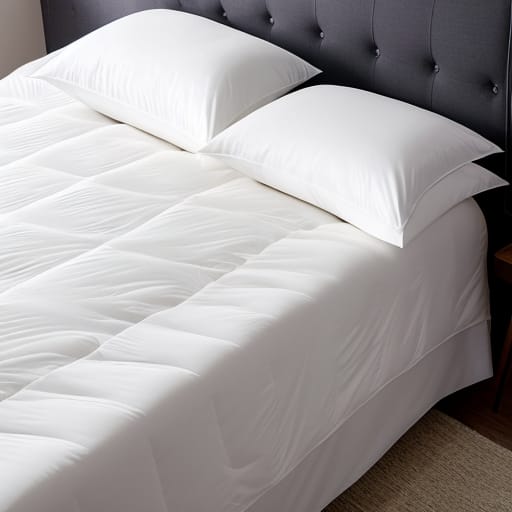Downfill comforters are like the coziest hugs imaginable and will transform any mattress into a fluffy cloud of cushiony comfort. But with so many options out there, choosing the right down-fill comforter for warmth, fluffiness, and durability can be confusing.
This beginner’s guide will teach you everything you need to know about down fill, fill power, fill weight, and picking the perfect down comforter for your needs. Read on to learn the answers to all your questions about duvet fill ratings, which duvets really insulate, and other factors that distinguish a quality down-filled comforter.
What is Down Fill?
Down is the soft, fluffy cluster of fibers found underneath the feathers of ducks and geese. These airy down clusters work to trap air and provide exceptional insulation for the birds. When used as a comforter filling, down offers an unmatched loft, durability, and lightweight warmth.
Understanding Down Fill Power
The fill power of a down comforter measures the loft and fluffiness of the downfill. Specifically, it refers to the number of cubic inches one ounce of down occupies. So an 800-fill power comforter means one ounce of its own will occupy 800 cubic inches when fully lofted.
In general, the higher the fill power:
- The better the insulation
- The more breathable and less dense the comforter
- The higher the overall quality
Fill powers typically range from 300 to 900. Down with fill powers under 400 lacks serious loft and insulation. The best quality comforters have to fill powers from 600 to 900. This exceptionally light and lofty down creates the most comfort and durability.
How Down Fill Power Impacts Insulation
Higher-fill power-down clusters have more empty space trapped within them. This is key since still air is an excellent insulator. Therefore, improved air trapping translates to better insulation against the cold.
An 800-fill power comforter with very fluffy, larger down clusters will trap more air than one with a tight 600-fill. So the 800 fill comforter keeps you warmer with less downweight.
Theoretically, improving the fill power reduces the downweight needed for equivalent warmth. But a lighter, higher-fill power comforter will cost more. The highest quality goose down with 800 to 900 fill power is exceptionally rare and pricey.
Debunking Myths About Fill Power
There are a few common misconceptions about fill power worth noting:
Myth: Higher fill power means a firmer, heavier comforter
Fact: Improved fill makes comforters feel lighter yet warmer.
Myth: Lower fill power is always cheaper
Fact: Lower grades often use more down to compensate, costing more.
Myth: Fill power guarantees comforter quality Fact: Shell materials and construction matter too.
So focus less on just fill power and more on the overall comforter quality and materials used. An 800 fill power comforter with a leaky, low thread count shell won’t be nearly as durable or comfortable as a better-made one with a 600 fill.
What is Fill Weight?
The amount of down stuffed inside a comforter is measured by its fill weight. This refers to the total weight of the down inside measured in ounces or grams.
Fill weight impacts:
- Overall warmth
- Total comforter weight
- Durability over time
- Price of the comforter
Lightweight comforters with less fill are convenient for warmer climates or summer use. But they won’t be as insulating.
Maximum warmth comforters are stuffed with tons of down and weigh much more. These can get very pricey but keep you ultra toasty in frigid environments.
Fill Weight and Insulation
More fill equals more trapped air pockets and better insulation. So increasing the fill weight boosts the overall warmth without needing to get a higher fill power down.
But after a point, adding more fill no longer improves warmth. Any down compressed underneath no longer lofts up to trap air.
That’s why the ideal fill weight balances adding enough fill for cozy warmth, without overstuffing which reduces performance.

Impact of Shell Materials and Stitching
A comforter’s outer shell plays a key role too. The shell needs to be breathable yet avoid down leakage over years of use. Popular shell options include:
- Egyptian Cotton: Ultra soft, breathable, luxurious
- Pima/ Supima Cotton: Smooth, durable and consistent
- American Upland Cotton: Affordable 100% cotton
- Percale Weave: Crisp, breathable, resists pilling
- Sateen Weave: Soft sheen, slight shimmer
Fill power measures down quality and loft. But a comforter also needs proper construction. The stitching pattern is evenly distributed instead of shifting around. Popular techniques include:
- Baffle Boxes: Even down distribution in sewn fabric pockets
- Gusseted Channels: Box-wall stitching for maximum insulation
- Diamond Quilting: Prevents cold spots with diamond-shaped boxes
So higher fill power down wrapped in a 300 thread count Egyptian cotton shell with baffle boxes will far outperform a lower quality shell that leaks over time.
How to Pick the Best Down Comforter
Selecting the ideal down comforter depends on many interrelated factors. Here are expert tips for finding your perfect match:
1. Choose a Fill Power Level For Your Needs
Warmer climates only require comforters with 600 to 700 fill power. But for colder regions, opt for a minimum of 700+ fill for proper insulation.
Those in extremely cold places like Alaska should consider the ultra-premium 800-900 fill power comforters.
2. Determine Ideal Fill Weight For Warmth
The right fill weight range depends on your warmth needs and local weather/seasons:
If you run hot but want basic warmth, start as low as 200-400g fill weight. For most people aiming for year-round use, target 400-600g fill weights.
In very cold regions, choose 600-800g+ fill levels for extra cozy insulation. Just avoid overstuffed options that reduce the down’s lofting power.
3. Select Shell Materials and Stitching
Ideally, look for down-proof shells using long-staple Egyptian or Pima cotton with a minimum 300 thread count. And prefer precision stitching like baffle boxes that limit cold zones.
Cheaper shells tend to leak over a few years while reducing breathability. So investing more upfront creates a comforter that lasts over a decade rather than needing frequent replacement.
4. Match the Size to Your Bed
Make sure to choose your comforter based on common blanket sizes:
Twin or XL comforters work great for guest rooms too. Just avoid the awkwardness of queen or king comforters left hanging off smaller beds.

Conclusion
That covers the complete beginner’s guide to understanding down fill power, fill weights and picking the perfect comforter for your bedroom. Focus on choosing the right fill power for your local climate needs and the ideal fill weight for maximum coziness.
Then select a quality cotton shell and precise stitching pattern so your comforter retains loft and lasts over a decade rather than leaking early. Follow these best practices for down comforters and enjoy your new favorite fluffy blanket for years to come!
Frequently Asked Questions
What is the best down fill power?
The ideal down fill power depends on your climate and seasons. For most people, a fill power between 600-800 provides the best balance of affordability, warmth, and durability. In warmer regions, 600-700 fill suffices while cold locations benefit from 800-900 fill power down.
How much down fill weight do I need?
The proper down fill weight ranges from as low as 200g for lightweight summer comforters up to 800g+ for ultra warm winter comforters. For year-round use, target a fill weight between 400-600g. Also factor in your climate, room temperatures and seasonal needs.
Is higher fill power warmer than more fill weight?
No, higher fill power does not directly relate to more warmth. It improves the down’s loft, breathability and efficiency. But a comforter with a very high 900 fill power and small 200g fill weight would not be as warm as one with a 600 fill and large 800g fill. Fill weight drives warmth, fill power drives quality and durability.
What thread count is best for a down comforter?
Look for down comforter shells with a minimum 300 thread count. This tighter weave provides downproofing to avoid leakage while remaining breathable. 400 thread count Egyptian or Pima cotton shells are ideal for strength, softness and longevity.
How do I wash a down comforter?
Use a large commercial washer on a gentle cycle with mild detergent to clean down comforters. Make sure to air or machine dry thoroughly on low until fully dry to restore fluffiness. Some manufacturers also offer special branded detergents and wash cycles tuned for cleaning down bedding.
Can I put a down comforter in a duvet cover?
Yes, placing your down comforter inside a duvet cover helps protect the shell fabric against stains and wear over time. Just make sure to get a duvet in the same size as your comforter. Adding a duvet cover also allows easy comforter cleaning since you simply wash the removeable duvet cover itself.
How long does a quality down comforter last?
With proper care, storage and cleaning, a high quality down comforter can last over 10 years before needing replacement. Investing in the right materials like long-staple Egyptian cotton shells prevents early leakage. And protecting it inside a removable duvet cover improves longevity.








